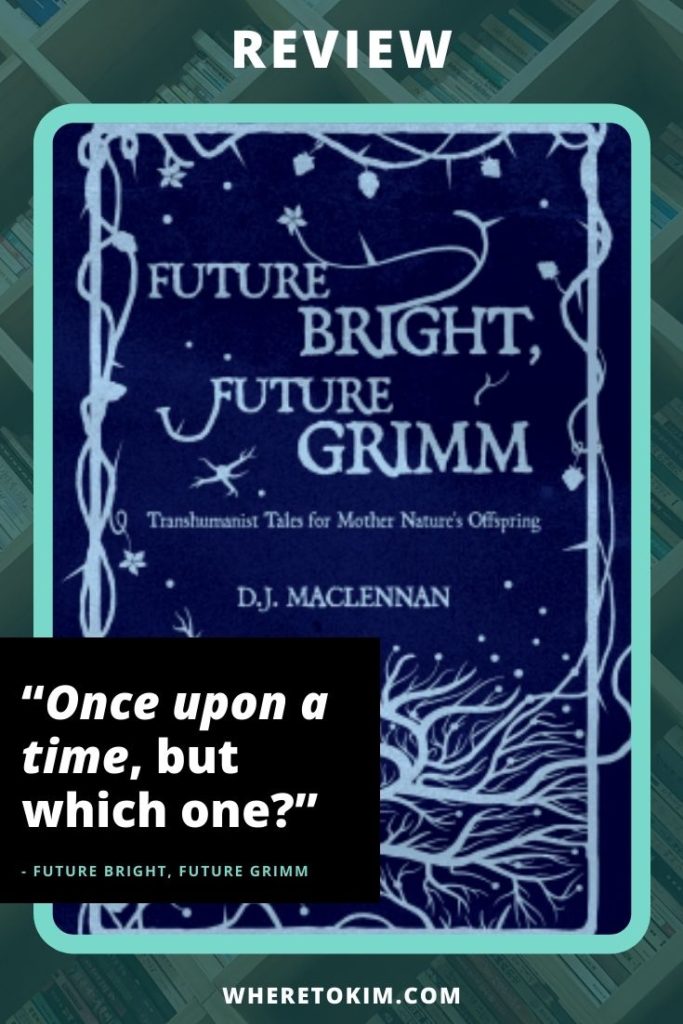In Future Bright, Future Grimm, D.J. MacLennan uses scientific progress to weave the necessary magic to turn the future into a fairy tale.
Future Bright, Future Grimm synopsis
Magic matters to people. Fairy tales matter. They’re all coming true.
Transhumanism – the rising global movement to supercharge human evolution with radical tech – heralds body- and mind-bending personal transformation. Yet it feels curiously familiar, like the dizzying fears and fantasies we probed in Germanic folklore as children.
Future Bright, Future Grimm draws upon the odd, abrupt, often violent tales of the Brothers Grimm to summon transhumanist tomorrows of astounding grace and danger. The adventurers, magicians and monsters who lurk here are we and our mind-children – amplified, augmented, immortalised in rebooted fables with the edgiest of twists.
This is magical realism inspired by the transfiguring technological sorcery that our species seems driven to conjure. Where the improbability of traditional fantasy meets the wildest possibilities of modern science and the coming ‘Singularity’.
Open doors – some dazzling, some dystopian – to enchanted mindscapes, unhinged. A storybook for changelings whose humble once-upon-a-times now spell truly outlandish ever-afters.
Book review
D.J. MacLennan explores what happens if you allow time to move on in a fairy tale realm. He redefines death, time and gender to create new fairy tale worlds, stepping away from the traditional medieval setting. In the introduction he explains the role of transhumanism in his stories. And indeed, in his stories you read about humankind’s accelerating transition to a qualitatively different, more marvelous mode of being.
Bending fairy tale reality
You dive into the stories with certain expectations, trying to notice all the winks to the future. Because of this attitude, the first stories you read don’t seem subtle at all, as there are multiple references to something futuristic, a modern trend (like minimalism) or school of thought in every paragraph.
Not all transitions are for the better, as is clearly illustrated by the story Asha which is based on Cinderella. Another fun story is Gingerbread, which unmistakably draws from Hansel & Gretel. Despite this being one of the “easier” stories, I won’t attempt to write a summary. Little Night Shard shows how “naming things – wresting them from the chaotic, unpronounceable background – may grant them immense, sometimes unwarranted, causal power.” This quote makes the story sound simple, but don’t let that mislead you.
D.J. MacLennan did something unique with all the original fairy tales of the Brothers Grimm.The predictability of the fairy tale motifs remains, but it is fun to read how differently things can turn out in another world.
Fairy tale manual
The stories don’t read as easily as the fairy tales I’m used to. This is partly because of the terminology, but also because of the writing style in general (long, detailed sentences). I noticed this less in the second half of the book. However, you do need to be relatively knowledgeable about transhumanism and technological advances to really understand what is happening in the story. And even then. I’m pretty sure I didn’t understand every aspect of them.
At the end of each story, the author explains the fairy tale that inspired it and the concepts he added to the story. You’ll also find references to characters from books, philosophical conventions, and other sources. I really looked forward to these explanations, sometimes even more than to the next story.
Recommendation
While Future Bright, Future Grimm is a fun book to read, it is certainly not for everyone. To illustrate that point, does the following short take-away from a story interest you? In the story The Foundling, checksums are performed based on the past predictability of a fairy tale data block, in the same way that a computer performs checksums.
It helps if you know (or look up) something about transhumanism and singularity, but you should also be familiar with the technology vocabulary. Without that knowledge, you won’t understand everything in the story, and that might hamper your reading experience.
Regardless of how much you understand, this book is an interesting showcase of how fairy tales can evolve into modern times. It shows how stuck we are in our expectations of things like fairy tale settings and the ways to move a story forward. If death is not the end, and time can go on indefinitely, I see many more creative ways to transform human storytelling. Having said that, if you reflect on the thoughts in the previous sentence, these concepts are not unknown to fairy tale worlds.
Interested?
Buy your copy of Future Bright, Future Grimm from Amazon.
Book details
Title: Future Bright, Future Grimm
Author: D.J. MacLennan
Language: English
Publisher: Anatta Books
Pages: 228
ISBN (13): 9780993334450
Publication date: 15 November 2021
About the author
D.J. MacLennan was born in 1971, in a now-demolished schoolhouse on the almost-drowned ‘island’ of Benbecula, in the Western Isles of Scotland. He signed up with Alcor in 2007, so that he can be cryopreserved upon his death.
He lives with his wife, Sarah, in a modern house on the coast of the Isle of Skye, in the Highlands of Scotland. Foraging for seafood on the shore in front of his house, sea-swimming, mindfulness meditation and perhaps just the odd dram of malt whisky, act as his antidotes for his tendency to become tangled in recursive coils of words in the depths of his non-existent self.
Many thanks to Anatta Books and NetGalley for a digital ARC of this novel in exchange for an honest review.







